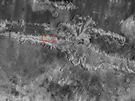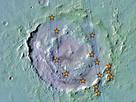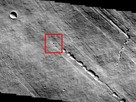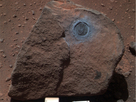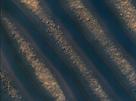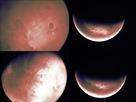ExoMars
Tracing the Big Picture of Mars' Atmosphere
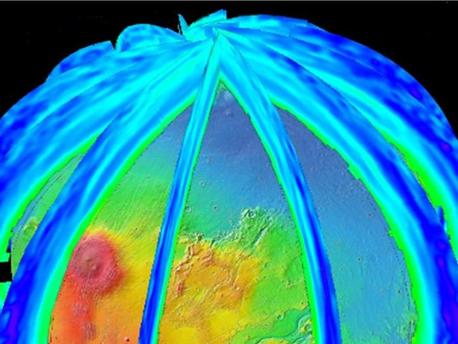 © NASA/JPL-Caltech
|
The Mars Climate Sounder instrument on NASA's Mars Reconnaissance Orbiter maps the vertical distribution of temperatures, dust, water vapor and ice clouds in the Martian atmosphere as the orbiter flies a near-polar orbit. This example of data from the instrument shows 13 orbits of nighttime temperatures at altitudes of zero to 80 kilometers (50 miles) above the surface, presented as curtains along the orbital track. Temperatures range from 120 Kelvin (minus 244 degrees Fahrenheit), coded purple, to 200 Kelvin (minus 100 degrees Fahrenheit), coded green. The data are from March 1, 2008, which was during early spring on northern Mars. The globe of Mars depicted under the curtains is a Google Earth product using elevation data from the Mars Orbiter Laser Altimeter on NASA's Mars Global Surveyor. The ExoMars Climate Sounder, selected in August 2010 as part of the science payload for the 2016 ExoMars Trace Gas Orbiter mission, will resemble the Mars Climate Sounder and provide similar types of data sets. The 2016 mission is a collaboration of the European Space Agency and NASA.
The European Space Agency and NASA have selected five instruments for ExoMars Trace Gas Orbiter. The European Space Agency will provide one instrument and the spacecraft. NASA will provide four instruments, including ExoMars Climate Sounder, which is coming from NASA's Jet Propulsion Laboratory, Pasadena, Calif.
Two of the other selected instruments are spectrometers -- one each from Europe and the United States -- designed to detect very low concentrations of methane and other important trace gases in the Martian atmosphere.
"To put the trace-gas measurements into context, you need to know the background structure and circulation of the atmosphere," said JPL's Tim Schofield, principal investigator for the ExoMars Climate Sounder. "We will provide the information needed to understand the distribution of trace gases identified by the spectrometers. We'll do this by characterizing the role of atmospheric circulation and aerosols, such as dust and ice, in trace-gas transport and in chemical reactions in the atmosphere affecting trace gases."
The ExoMars Climate Sounder is an infrared radiometer designed to operate continuously, day and night, from the spacecraft's orbit about 400 kilometers (about 250 miles) above the Martian surface. It can pivot to point downward or toward the horizon, measuring temperature, water vapor, dust and ices for each 5-kilometer (3-mile) increment in height throughout the atmosphere from ground level to 90 kilometers (56 miles) altitude.
Schofield and his international team have two other main goals for the investigation, besides aiding in interpretation of trace-gas detections.
One is to extend the climate mapping record currently coming from a similar instrument, the Mars Climate Sounder, on NASA's Mars Reconnaissance Orbiter, which has been working at Mars since 2006. The orbital geometry of the Mars Reconnaissance Orbiter mission enables this sounder to record atmospheric profiles only at about 3 p.m. and 3 a.m. during the Martian day, except near the poles. The ExoMars Trace Gas Orbiter will fly an orbital pattern that allows the spacecraft to collect data at all times of day, at all latitudes.
"We'll fill in information about variability at different times of day, and we'll add to the number of Mars years for understanding year-to-year variability," said Schofield. "The most obvious year-to-year change is that some years have global dust storms and others don't. We'd like to learn whether there's anything predictive for anticipating the big dust storms, and what makes them so variable from year to year."
A third research goal is to assist future landings on Mars by supplying information about the variable density of the atmosphere. At a chosen landing site, atmospheric density can change from one day to the next, affecting a spacecraft's descent.
"We want to provide background climatology for what to expect at a given site, in a given season, for a particular time of day, and also nearly real-time information for the atmospheric structure in the days leading up to the landing of a spacecraft launched after 2016," said Schofield.
The 2016 ExoMars Trace Gas Orbiter is the first in a series of planned Mars mission collaborations of the European Space Agency and NASA. A variable presence of small amounts of methane in the Martian atmosphere has been indicated from orbital and Earth-based observations. A key goal of the mission is to gain a better understanding of methane and other trace gases that could be evidence about possible biological activity. Methane can be produced both biologically and without life.
Besides the two spectrometers and the climate sounder, the orbiter's selected instruments include two NASA-provided imagers: a high-resolution, stereo, color imager, and a wide-angle, color, weather camera. The orbiter will also serve as a communications relay for missions on the surface of Mars and will carry a European-built descent-and-landing demonstration module designed to operate for a few days on the Mars surface. JPL, a division of the California Institute of Technology, manages NASA's roles in the mission.
Source: NASA
ExoMars
Tracing the Big Picture of Mars' Atmosphere
 © NASA/JPL-Caltech
|
The Mars Climate Sounder instrument on NASA's Mars Reconnaissance Orbiter maps the vertical distribution of temperatures, dust, water vapor and ice clouds in the Martian atmosphere as the orbiter flies a near-polar orbit. This example of data from the instrument shows 13 orbits of nighttime temperatures at altitudes of zero to 80 kilometers (50 miles) above the surface, presented as curtains along the orbital track. Temperatures range from 120 Kelvin (minus 244 degrees Fahrenheit), coded purple, to 200 Kelvin (minus 100 degrees Fahrenheit), coded green. The data are from March 1, 2008, which was during early spring on northern Mars. The globe of Mars depicted under the curtains is a Google Earth product using elevation data from the Mars Orbiter Laser Altimeter on NASA's Mars Global Surveyor. The ExoMars Climate Sounder, selected in August 2010 as part of the science payload for the 2016 ExoMars Trace Gas Orbiter mission, will resemble the Mars Climate Sounder and provide similar types of data sets. The 2016 mission is a collaboration of the European Space Agency and NASA.
The European Space Agency and NASA have selected five instruments for ExoMars Trace Gas Orbiter. The European Space Agency will provide one instrument and the spacecraft. NASA will provide four instruments, including ExoMars Climate Sounder, which is coming from NASA's Jet Propulsion Laboratory, Pasadena, Calif.
Two of the other selected instruments are spectrometers -- one each from Europe and the United States -- designed to detect very low concentrations of methane and other important trace gases in the Martian atmosphere.
"To put the trace-gas measurements into context, you need to know the background structure and circulation of the atmosphere," said JPL's Tim Schofield, principal investigator for the ExoMars Climate Sounder. "We will provide the information needed to understand the distribution of trace gases identified by the spectrometers. We'll do this by characterizing the role of atmospheric circulation and aerosols, such as dust and ice, in trace-gas transport and in chemical reactions in the atmosphere affecting trace gases."
The ExoMars Climate Sounder is an infrared radiometer designed to operate continuously, day and night, from the spacecraft's orbit about 400 kilometers (about 250 miles) above the Martian surface. It can pivot to point downward or toward the horizon, measuring temperature, water vapor, dust and ices for each 5-kilometer (3-mile) increment in height throughout the atmosphere from ground level to 90 kilometers (56 miles) altitude.
Schofield and his international team have two other main goals for the investigation, besides aiding in interpretation of trace-gas detections.
One is to extend the climate mapping record currently coming from a similar instrument, the Mars Climate Sounder, on NASA's Mars Reconnaissance Orbiter, which has been working at Mars since 2006. The orbital geometry of the Mars Reconnaissance Orbiter mission enables this sounder to record atmospheric profiles only at about 3 p.m. and 3 a.m. during the Martian day, except near the poles. The ExoMars Trace Gas Orbiter will fly an orbital pattern that allows the spacecraft to collect data at all times of day, at all latitudes.
"We'll fill in information about variability at different times of day, and we'll add to the number of Mars years for understanding year-to-year variability," said Schofield. "The most obvious year-to-year change is that some years have global dust storms and others don't. We'd like to learn whether there's anything predictive for anticipating the big dust storms, and what makes them so variable from year to year."
A third research goal is to assist future landings on Mars by supplying information about the variable density of the atmosphere. At a chosen landing site, atmospheric density can change from one day to the next, affecting a spacecraft's descent.
"We want to provide background climatology for what to expect at a given site, in a given season, for a particular time of day, and also nearly real-time information for the atmospheric structure in the days leading up to the landing of a spacecraft launched after 2016," said Schofield.
The 2016 ExoMars Trace Gas Orbiter is the first in a series of planned Mars mission collaborations of the European Space Agency and NASA. A variable presence of small amounts of methane in the Martian atmosphere has been indicated from orbital and Earth-based observations. A key goal of the mission is to gain a better understanding of methane and other trace gases that could be evidence about possible biological activity. Methane can be produced both biologically and without life.
Besides the two spectrometers and the climate sounder, the orbiter's selected instruments include two NASA-provided imagers: a high-resolution, stereo, color imager, and a wide-angle, color, weather camera. The orbiter will also serve as a communications relay for missions on the surface of Mars and will carry a European-built descent-and-landing demonstration module designed to operate for a few days on the Mars surface. JPL, a division of the California Institute of Technology, manages NASA's roles in the mission.
Source: NASA





